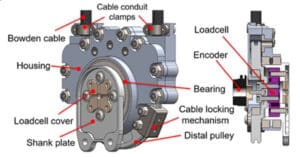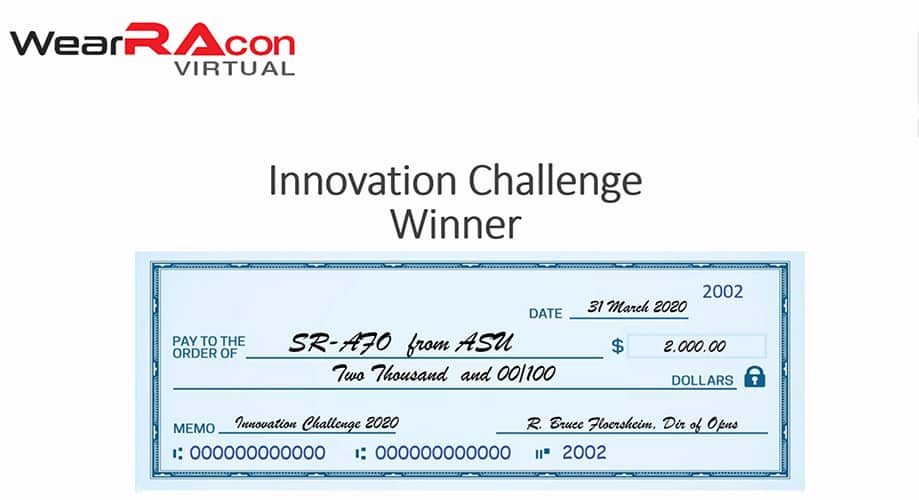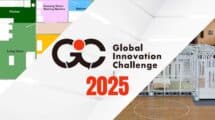As the Wearable Robotics Association Conference 2020 (WearRAcon 20) moved to a virtual format so did its main-stage event, the WearRA Innovation Challenge. For its 5th year, individuals, academic groups, and startups still had a chance to present in front of the main conference body in an elevator pitch 5-minute format but remotely from the comfort of their homes. Submissions still took place as normal and a group of five finalists was selected to present.
The display space normally reserved for participants for the competition was instead substituted with a live webspace that highlights the work, videos, and posters created by the finalists in the challenge: Innovation Challenge Finalist Presentations. The site is free to access for the entire exoskeleton community without having to have been registered to WearRAcon 20.
Unlike the previous iterations, all the registered attendees were judges this year and voting was done electronically. The main award was $2,000 and free entry to the next WearRAcon, while the runner-up received $500. It should be noted that past winners have found that the exposure to the industry provided by placing in the top two has been the most beneficial to them in their future work and fundraising.
Winner: Soft Robotic Ankle-Foot Orthosis (SR-AFO) Exosuit for Plantarflexion Assistance
Team members: Marielle Debeurre, Carly Thalman, Tiffany Hertzell, and Hyunglae Lee, Arizona State University
Current braces are stiff and uncomfortable. What if we could have a dynamic brace that is constantly adjusting itself with each step? The prototype uses two groups of soft inflatable actuators that actively adapt to the user. One set braces the leg while the other assists with leg push-off. The team does not know of similar soft robotic orthotics with multiple degrees of freedom, however, they do not envision turning their work into a product before 2023.
Second Place (in a tie): UnOrthoDOKS: Unibody Orthotic Device for OA Knee Support
Team members: Danish Shaikh, Assistant Professor, University of Southern Denmark
Osteoarthritis is incurable and restricts motion and is usually focused on the knee area. This is a silent disease with as many as 90 million people suffering from this worldwide. Living with it is painful. Commonly, a knee brace is used to stabilize the leg. The device proposed uses a 3D printed modular design that adapts for the comfort of the knee.
UnOrthoDOKS is meant to go beyond the capabilities of a passive brace. It bends away during knee contraction to allow for cooling of the area. This is a fully customizable ergonomics device vs. what is currently on the market which can only be partially customized. The business model envisioned is that 3D scanning will also be provided as an additional service to customers, so they can drop in, get their knee 3D scanned, and then receive a custom manufactured unit. The team is now working with a Denmark robotics incubator and have already completed their IP search for similar inventions.
Second Place (in a tie): Omnics Exoskeleton
Team members: Hao Su, Assistant Professor, The City University of New York, City College

Exoskeletons are heavy and expensive. For medical and walking assist exos, historically the focus has been on those recovering from spinal cord injury and stroke. But what if we could build a personal exoskeleton for every user?
This would first require a lighter and higher energy density motor says Dr. Hao Su. The project goal is to develop small, smart but cost-effective motors for exoskeletons. The motors don’t have to be connected to the joint being actuated but could be on a backpack and run Bowden cables.
As is the case with all other Innovation Competition entries, there is significantly more detailed information on the WearRA website.
Finalist: Astrek Innovations
Presenter: Robin Thomas, Co-Founder & CEO
Askrek Innovations is an exoskeleton startup company headquartered in Kerala, India. The CEO, Robin Thomas became interested in walking assist devices after his grandfather lost his ability to walk due to an accident. This is a sizable group, says Robin Thomas, with the W.H.O. organization estimating that there are 500,000 people affected yearly. Even without an accident, everyone can relate to a relative who has gone through a decrease in their physical mobility. Astrek Innovations is proposing an open-source solution for a wheeled walking exoskeleton that provides stability and a natural walking pattern. The company has already collaborated with multiple hospitals. The next goal is to be able to provide a kit for implementation and further improvements.
The idea presented here is an interesting one: gait assisting exoskeletons are usually either self-enclosed or connected to a rail or stationary frame. What if part the exo-system is wheeled and accompanies the wearable robot instead? There is previous exo research on wheeled devices (that may contain the exoskeleton’s controller or batteries for example) which either follow or lead the user. The solution shown here is different: a wheeled device that always stays with the exoskeleton and assists with sit-to-stand.
Finalist: Robocast
Team members: Mohamed Saqeeb Mandlik and Mohamed Ishag Hassan, Robocast
Robocast dares to dream big! What if in the distant (or maybe not so distant) future wearable robotic devices act as a mobile hospital that travels with you? The team presented a concept of a wearable unit that could be customized as needed. The intention is to start with a device that collects medically relevant data from the user but could also provide assistance (one idea that has been raised in the past is to sonicate a broken or fractured bone to facilitate faster healing).
Congratulations to all of the finalists and the winner of the 2020 WearRA Innovation Challenge!
Reference, posters and videos:
Innovation Challenge Finalist Presentations, WearRAcon 20 Virtual, http://www.wearablerobotics.com/wearracon-20/innovation-challenge/
Updated May 7, 2020, to include that the UnOrthoDOKS business model envisioned will include 3D scanning as an additional service.









Add Comment